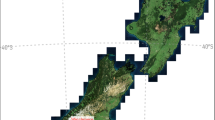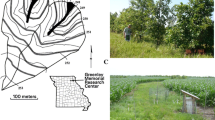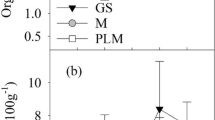Abstract
An experiment was conducted near Ithaca, New York, to compare orchard soil and groundcover management systems (GMSs) in a silty clay loam soil (mixed, mesic, Glosaquic Hapludalf). Three replications of four GMS treatments were randomly assigned to 12 plots and maintained since 1992 in 2 m-wide strips within tree rows: (1) Sod: Red fescue (Festuca rubra) turfgrass mowed biweekly; (2) Post-HBS: Post-emergence applications of glyphosate herbicide in May and July annually; (3) Pre-HBS: Pre-emergence applications of paraquat, diuron and norflurazon herbicides each May; and (4) Mulch: A 15-cm depth layer of shredded hardwood bark mulch, renewed triennially. After eight years of continuous treatments, we compared soil physical conditions and hydraulic properties in these GMSs. Bulk density was lower and soil porosity greater under Mulch than other GMSs. Infiltration was more rapid under Mulch than other GMSs, and under Post-HBS than Sod. Saturated hydraulic conductivity ranged from 6 × 10−4 m.s−1under Sod to 12 × 10−4 m.s−1 under Mulch plots, and was equivalent in Sod and Pre-HBS, lower in Sod than Post-HBS or Mulch treatments, higher in Post-HBS than Pre-HBS, and higher in Mulch than all other GMSs. Volumetric soil water content at field capacity ranged from 0.47 under Mulch to 0.40 under Sod, and was not significantly different among GMSs between 0.99 and 39.22 kPa of pressure. GMS treatments and related management practices at this orchard had substantially different long-term effects on soil physical conditions. Compaction and reduced infiltration in Sod compared with other GMSs were attributed to tractor wheel traffic during mowing. Mulch treatments improved soil conditions relative to other GMSs. Greater infiltration rates and hydraulic conductivity under Post-HBS compared with Pre-HBS suggest relative advantages of post-emergence herbicides.
Similar content being viewed by others
References
Analytical Software 1998 Statistix for windows, user's manual. Analytical Software, Tallahassee, FL. 350 p.
Anderson J L, Bingham G E and Hill R W 1992 Effects of permanent cover crop competition on sour cherry tree evapotranspiration, growth and productivity. Acta Hort. 313, 135–142.
Atkinson D 1980. The distribution and effectiveness of the roots of tree crops. Hort. Rev. 2, 424–481.
Bugg R L and Waddington C 1994 Using cover crops to manage arthropod pests of orchards: A review. Agric. Ecosyst. Environ. 50, 11–28.
Danielsen R E and Sutherland P L 1986 Porosity. In Methods of Soil Analysis, Part 1, 2nd edn. Ed. A Klute. pp 443–461. Agron. No 9, Am. Soc. Agron., Madison, WI.
Gill WR and Berg G E 1967 Soil Dynamics in Tillage and Traction. Agriculture Handbook 316, ARS, USDA, US Gov. Print. Office, Washington, DC.
Glenn D M and Welker W V 1989 Orchard soil management systems influence rainfall infiltration. J. Am. Soc. Hort. Sci. 114, 1014.
Haynes R J 1980 Influence of soil management practices on the orchard agro-ecosystem. Agro-Ecosyst. 6, 3–32.
Hipps N A and Samuelson T J 1991 Effects of long-term herbicide use, irrigation and nitrogen fertilizer on soil fertility in a apple orchard. J. Sci. Food Agric. 55, 377–387.
Hogue E J and Neilsen G H 1987 Orchard floor vegetation management. Hort. Rev. 9, 377–430.
Hoyt G D and Hargrove WL 1986 Legume Cover Crops for Improving Crop and Soil Management in the Southern United States. HortScience 21, 397–402.
Hurto K A, Turgen A J and Spomer L A 1980 Physical characteristics of thatch as a turfgrass growing medium. Agron. J. 72, 165–167.
Jorajuria D and Draghi L 1997 The distribution of soil compaction with depth and the response of a perennial forage crop. J. Agric. Engng. Res. 66, 261–265.
Klute A 1986 Water retention: laboratory methods. InMethods of Soil Analysis, Part 1, 2nd edn. Ed. A Klute. pp 635–662. Agron. No 9, Am. Soc. Agron., Madison, WI.
Klute A and Dirksen C 1986 Hydraulic conductivity and diffusivity: laboratory methods. In Methods of Soil Analysis, Part 1, 2nd edn. Ed. A Klute. pp 687–734. Agron. No 9, Am. Soc. Agron., Madison, WI.
Kutilek M 1980 Constant rainfall infiltration. J. Hydrol. 45, 289–303.
Lipecki J and Berbec S 1997 Soil management in perennial crops, orchards and hop gardens. Soil Till. Res. 43, 169–184.
Merwin I A 1993 Alternatives to herbicides for orchard weed control. New York State Fruit Quarterly 7, 6–8.
Merwin I A, Rosenberg D A, Engle C A, Rist D L and Fargione M 1995 Comparing mulchs, herbicides and cultivation as orchard groundcover management systems. HortTechnology 5, 151–158.
Merwin I A, Stiles W C and Van E S H M 1994 Orchard groundcover management impacts on soil physical properties. J. Am. Soc. Hort. Sci. 119, 216–222.
Miyazaki T 1993 Water flow in soils. Marcel Dekker, New York.
Murray J J and Juska F V 1977 Effect of management practices on thatch accumulation, turf quality and leaf spot damage in common Kentucky Bluegrass. Agron. J. 69, 365–369.
Ogden C B, Van Es H M and Schindelbeck R R 1997 Miniature rain simulator for field measurement of soil infiltration. Soil Sci. Soc. Am. J. 61, 1041–1043.
Parker M L and Meyer J R 1996 Peach tree vegetative and root growth respond to orchard floor management. HortScience 31, 330–333.
Reynolds WD and Elrick D E 1990 Ponded infiltration from a single ring: I. Analysis of steady flow. Soil Sci. Soc. Am. J. 54, 1233–1241.
Skroch WA and Shribbs J M 1986 Orchard Floor Management: An Overview. HortScience 21, 390–393.
Tisdall J M 1989 Soil management. Acta Hort. 240, 161–168.
White R H and Dickens R 1984 Thatch accumulation in Bermudagrass as influenced by cultural practices. Agron. J. 76, 19–22.
Author information
Authors and Affiliations
Corresponding author
Rights and permissions
About this article
Cite this article
Oliveira, M.T., Merwin, I.A. Soil physical conditions in a New York orchard after eight years under different groundcover management systems. Plant and Soil 234, 233–237 (2001). https://doi.org/10.1023/A:1017992810626
Issue Date:
DOI: https://doi.org/10.1023/A:1017992810626




